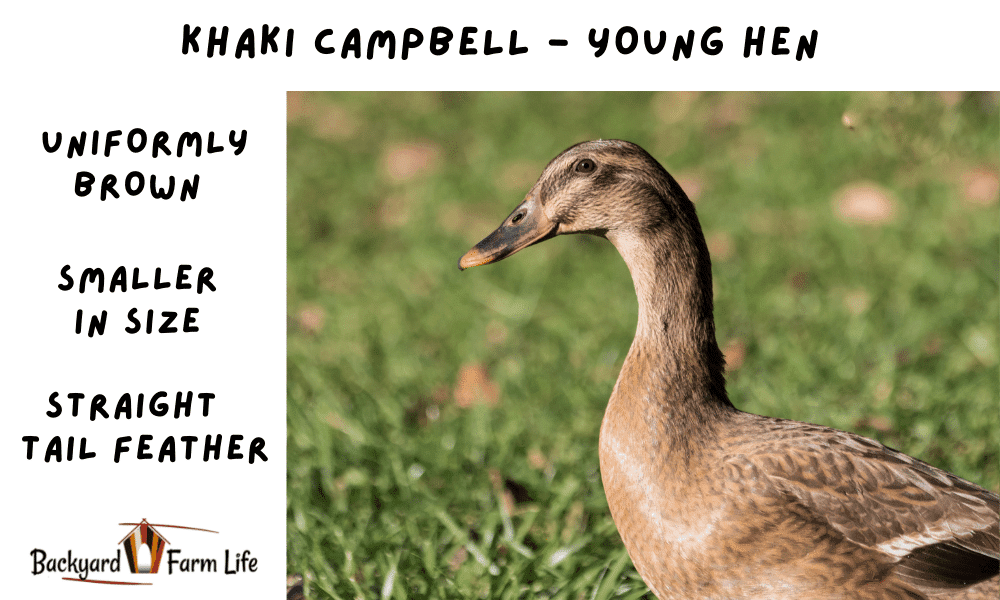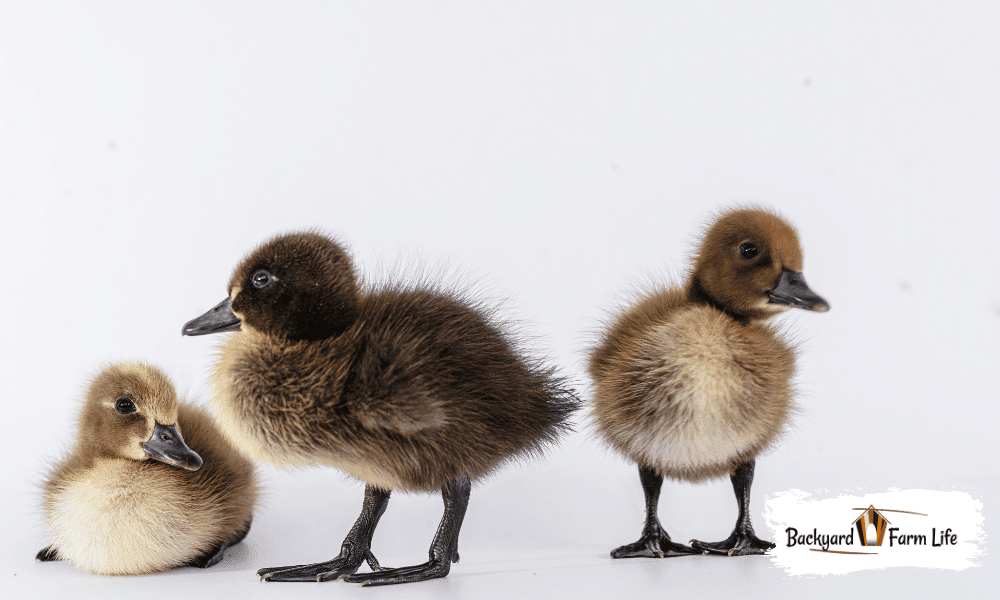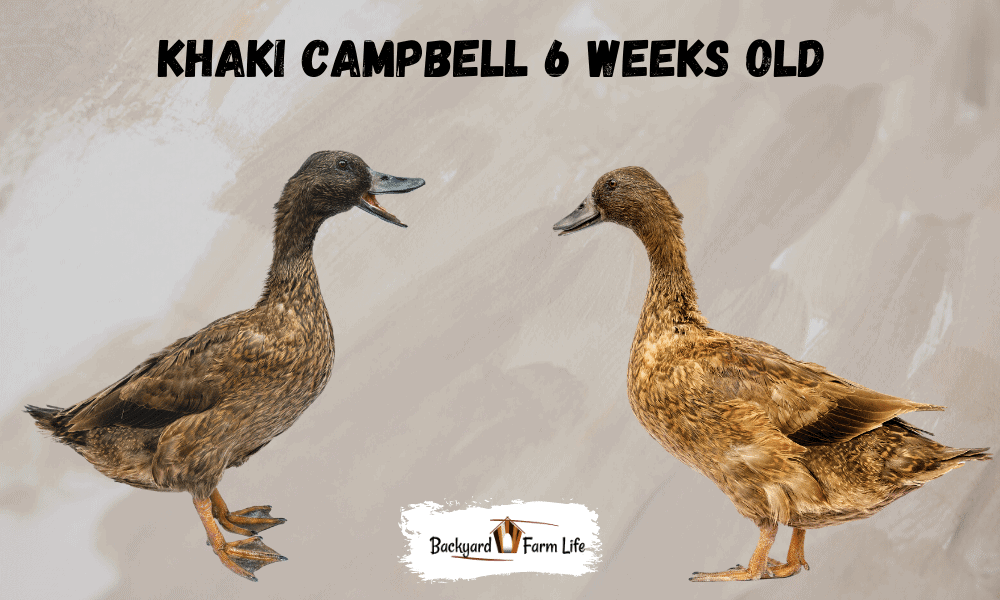If you’ve got yourself some Khaki Campbell ducks then you’re in for some of the best times of your life!
These ducks are incredible, being slightly smaller and more domesticated than Pekins or Cayugas, but having big personalities with wonderful temperaments too.
As a mature duck, you can rely on a few key physical differences that help determine whether you’ve got yourself a male duck (drake) or female duck (hen).
At a younger age things can be a bit more challenging.
So you know exactly what you’ve got, here are the main differences between male and female Khaki Campbell ducks, and how you can tell the difference at all ages from ducklings to 4 weeks old, to 8 weeks, to maturity!
Contents
Khaki Campbell Ducks: Male or Female?


With some breeds of poultry, trying to determine whether you’ve got a male or female can be somewhat of a challenge. Take silkie roosters and hens for example – up until maturity they just look so similar!
Luckily, when it comes to Khaki Campbell ducks, there are a few key physical differences that you can use to determine whether it’s a male or female.
You can’t exactly base it on their reproductive organs as their inside their body! But, between male and female Khaki Campbell ducks, you will observe a clear difference in size, plumage color, tail feathers, bills, and feet.
Another useful difference you can use in your investigation is listening to their quacks, and observing mating or egg-laying behavior.
Here’s everything in detail, to help you differentiate Khaki Campbell drakes from the Khaki Campbell hens.
Size
Khaki Campbells are considered a medium size duck overall. But, from about 8 weeks old the Khaki Campbell drakes will appear visually larger than the hens.
At maturity, a male Khaki Campbell duck will weigh roughly 5-6 pounds, whereas females remain at about 4 to 4 ½ pounds.
Furthermore, a Khaki Campbell drake will stand taller and be bulkier than the Khaki Campbell hens! But don’t worry, both male and female Khaki Campbell ducks can’t fly!
Plumage
Probably one of the easiest differences to spot between a Khaki Campbell male and female is by observing the color of their plumage, particularly the head.
From as young as 6-8 weeks old and all through maturity, male Khaki Campbell ducks will have a much darker brown or dark green head and neck. On the other hand, female Khaki Campbell ducks will almost always be completely uniform in their color. Usually, this presents as a nice light brown from head to tail feather.
Aside from the head, Khaki Campbell drakes will also have a much more mild khaki hue and can have lighter and darker shades across their lower back and lower part of their breast
So, by simply looking out for distinctly darker brown or green heads on your ducks you can point out the males from the females!
Tail Feathers
The presence of a prominent, curly tail feather can also be a good differentiating factor between Khaki Campbell males and females.
In most cases, when the drakes grow their mature feathers they will have one larger curly tail feather, whereas the hens will have straight tail feathers.
However, this isn’t always foolproof!
Sometimes drakes might not have a curly tail feather. But, the observance of a curly tail feather is mostly in males, so you can still use this in your investigation!
Bill
Khaki Campbell drakes normally have greenish-blue bills that can get very dark. The hens, on the other hand, have slate golden yellow bills.
This is considered the norm, and will appear in roughly 80-90% of Khaki Campbells. But, this isn’t always the case, but can still be one of the many tells between male and female Khaki Campbells.
Legs
Both the color and overall size of the legs and feet differ between male and female Khaki Campbell ducks.
Generally, males will have orange legs and feet while the color of the females leg’s and feet are often duller or closer to brown.
In chickens, roosters generally grow larger claws or talons. However, in Khaki Campbell ducks, both males and females grow the same size claws on their feet.
Sound
Setting aside physical differences, there is one very real factor you can use to differentiate a Khaki Campbell drake from a hen, and it comes from their quacks.
That is, not only will Khaki Campbell males quack less than the females, but they will be much deeper and almost raspy in their sound.
Khaki Campbell females will almost always have a very traditional quack, and they aren’t afraid of verbalizing their feelings! Females are generally much louder and have a much more distinct quack.
This goes for other duck breeds too, like Cayuga male and female ducks.
If you hear quacking at night, it’s more likely the females than the males!
Telling The Difference Between Male & Female Khaki Campbell Baby Ducks

So, as an adult duck, Khaki Campbell’s have several physical differences between the males and females – so it’s not too challenging to tell the difference!
However, from a younger age, not all these physical differences are present. Instead, as your ducks grow you can look out for the physical traits which appear at different ages.
As young ducks, you can still look for the color in the head, the presence of curly tail feathers, size, and of course, the quack.
0-4 Week Old Khaki Campbell Ducks
As cute as Khaki Campbell ducklings are, from 0-to 4 weeks old it’s very hard to tell the difference between males and females. Unless you’re a professional or have prior experience in determining male and female baby ducks, there is very little to rely on.
This is because at this age there is very little size difference between the males and females, and they have yet to grow out of their baby feathers!
Both Khaki Campbell male and female ducklings are dark browns to black with sometimes tiny white plumage on their breast.
4-8 Week Old Khaki Campbell Ducks

From about four weeks old there are some clear physical differences that begin to appear between male and female Khaki Campbell ducks.
At four weeks old, the male Khaki Campbell duck will begin showing a much darker color on its head, wing, and lower back. The females will remain a uniform brown all over. This is much more distinguished at ages 6-8 weeks though.
As well as the physical, after about 4-6 weeks you will begin hearing a clear vocal difference in their quacks, as their vocal cords develop differently.
A male Khaki Campbell will have a low, raspy quack, and a female Khaki Campbell will start making traditional, higher-pitched quacks.
8-16 Week Old Khaki Campbell Ducks
From 8 weeks old most of the physical differences will be present between the males and females, although may not be fully pronounced until maturity at around 16 weeks.
Still, from 8 weeks old you will notice a clear size difference in the males over the females, and dark colors will be developed on males’ heads and necks
You may also see the presence of a curly tail feather in males and a more yellowish beak than that of females.
From as young as 10 weeks old you will also start to notice behavioral differences too! Males will become more dominant and may even try mounting other ducks. Females will remain timider.
In A Nutshell
Luckily the Khaki Campbell duck shows some pretty clear physical, behavioral, and vocal differences between the males (drakes) and females (hens).
Even from a young age of 4 weeks old, males will begin to show much darker heads and necks, whereas female Khaki Campbells will remain one uniform brown color for their whole life.
You’ll also hear a male Khaki Campbell duck’s quack being much lower and raspier than the distinct traditional quack of a female.
At maturity, all of these differences can be used to pinpoint the males from the females.
But, if you have any questions feel free to leave a comment or post on our Facebook page and we’ll happily take a look at what you’ve got!
Happy backyard farming everyone!

At what age do you start seeing difference in leg and feet color?
Hey George,
It happens gradually, but you may start seeing a difference from about 6-12 weeks old. Just be aware not all of the male’s feet will turn orange, but it is still one tell you can use.
Thanks!
I have three to light ones I saw her get mounted by the other light color one today she poped an egg the other is dark but all three quack its very confusing
Hey Chad! How old are they?
It’s not uncommon for females to mount each other at younger ages too which can make it a bit confusing!
We had a pair of Khaki Campbell’s, a dog killed the drake. She was sitting on eggs. 5 ducklings hatched. I also am having trouble sexing them. I guess it’s a waiting game. To see how many females we get..